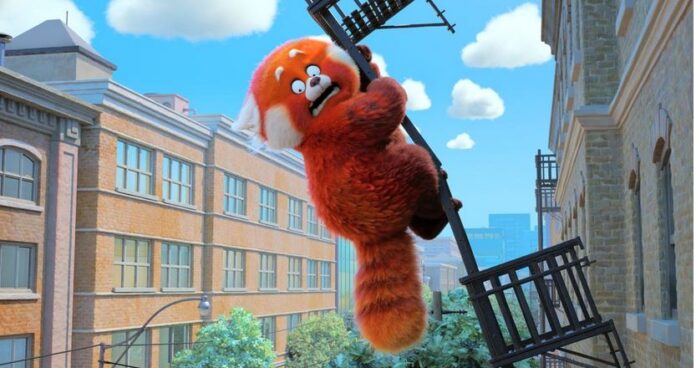By Jana Monji, AsAmNews Arts & Culture Reporter
The tween years are tricky, you’re tripping toward adulthood and gender presentation but the journey is long and you’ve just begun. You have childish thoughts and adult-ish emotions. Pixar’s Turning Red has a humorous approach to a red curse and the maternal bonds that rise during puberty. Academy Award-winning Chinese Canadian Domee Shi draws from her childhood in writing with Julia Cho (Big Love, Betrayal and Fringe) for a fun and fuzzy directorial debut.
Weird things can be wonderful, including weirdly controversial reviews and comments–something I address in another essay.
- The Text of Sean O’Connell’s Infamous ‘Turning Red’ Review
- Analyzing Sean O’Connell’s Infamous ‘Turning Red’ Review
Meilin Lee (Rosalie Chiang) thinks she knows who she is. The Toronto Transit Commission considers 13-year-old passengers officially adults and she’s happy to have joined that club. Mei is every parents’ dream of a high-achieving child. She’s not only mastered her academic classes, she has musical talent as well. She has her gal pals: a tall Caucasian girl with braces named Miriam (voiced by Ava Morse), Indo-Canadian friend Priya (Maitreyi Ramakrishnan) and Korean Canadian Abby (Hyena Park). The girls are in full force young girl feverish infatuation for a multicultural boy band called 4*Town–Robaire (Jordan Fisher), Aaron Z. (Josh Levi), Aaron T. (Topher Ngo), Jesse (Finneas O’Connell) and Tae Young (Grayson Villanueva).
While Mei would like to hang out more with her friends, she also has chores to do with her tiger mother Ming Lee (Sandra Oh). She lives in a house next to one of the oldest temples in Toronto. Instead of the traditional stone Chinese guardian lions (石獅; shíshī)–you might know these better as foo dogs, this temple has stone red pandas guarding the entryway.
The temple is a matrilineal responsibility (Her father, Jin Lee (Orion Lee) does the cooking.) and we soon learn why. The women share a family curse: when they reach puberty, they turn into a large red panda. By large, I mean not the under 20 lbs. you might expect from a red panda in the wild, but more like the 280 lbs. of a giant black and white panda. That’s hard to hide and sometimes the transformation isn’t complete–it might just be a fluffy tail hanging out. But Mei can control her transformation by remaining calm. The curse can be best controlled by a special ritual that must be done on a red moon night, but that’s the night that Mei and her girl group want to attend the 4*Town concert.
When I was 13, I was a morose accelerated student with an A average. I remember junior high as sweaty and embarrassing. If I had been born later, being a geek or nerd, might have been cool and I could have gone full goth and had a tribe. My family was falling apart due to a catastrophic longterm illness that would ultimately claim my father when I was 14. (Don’t worry. There won’t be any parental death in this Pixar film and Meilin isn’t a Disney princess.) I feel as if I almost skipped over that time of silly girlishness portrayed in this film.
What I didn’t skip over was the puberty-sparked hair growth on places other than my head and the need to keep track of my internal calendar. Suddenly, there’s a practical reason for always having a purse. “Be prepared,” may be the Boy Scouts’ motto, but for girls and women, it is a way of life during their fertile lifespan.
In VoiceOver, Meilin proudly tells the audience, “The number one rule in my family: honor your parents…they are the supreme beings who gave you life who sweated and sacrificed so much…The least you can do in return is every single thing they ask.” If that sounds horrifying to anyone, there’s a caveat, Mei says, “honoring your parents sounds great if you take it too far you might forget to honor yourself.”

Initially, her parents mistake Mei’s dismay for another type of red curse–menstruation. If you’re offended by tampons and pads, they are unabashedly on display here. And some of Mei’s initial reaction to her inner red panda coming out, isn’t far from the problems faced by young girls who are caught unprepared–hiding out in the bathroom and being afraid of what your backside is showing.
Shi was born in China (Chongqing), but grew up in Toronto. She’s writing about what she knows. In 2018, she became the first woman to direct a Pixar short and that short, Bao, won an Oscar. The story for Turning Red is an original concept that she pitched to Pixar in 2017 and the story was developed by Shi, playwright Julia Cho and Sarah Streicher. The Los Angeles-born Korean American Cho is a Windham-Campbell Literature Prize awardee and was the story editor on Big Love during 2010. Together, they’ve made a girl power animated feature of the Asian descent variety that is warm and fuzzy. It’s a welcome addition for family films, especially for people who love furry animals. Turning Red is about learning how to balance familial expectations and honoring oneself and that should be a universal experience for most people.
Shi called the film a love letter to a certain time in our lives, to Toronto, and to puberty. This is a lovely film for girls and boys and for families and a window into Toronto. I didn’t think it would cause controversy, but it has and that may be a wake-up call for many publications that have neglected their population of East Asian descent. The forever foreigner feeling people of East Asian descent feel is quite real, and films like this can help in erasing that problem. I didn’t realize how important this film was until I read Sean O’Connell’s review. Representation matters and Pixar and Disney are on the right track.
Turning Red premiered in London, England on 21 February 2022. It is scheduled to be released on 11 March 2022 on Disney+ in countries where the service is available as well as for a limited run at the El Capitan Theatre. In countries where Disney+ is not available, the film will have a theatrical release.
- The Text of Sean O’Connell’s Infamous ‘Turning Red’ Review
- Analyzing Sean O’Connell’s Infamous ‘Turning Red’ Review
AsAmNews has Asian America in its heart. We’re an all-volunteer effort of dedicated staff and interns. Check out our new Instagram account. Go to our Twitter feed and Facebook page for more content. Please consider interning, joining our staff, or submitting a story, or making a contribution.



I enjoyed Pixar’s Turning Red for the most part, but can someone please tell Pixar that “chop, chop” is derogatory phrase against Asians? With so many Asians working on the production, shame on them! Perhaps it’s better that in the actual dialogue, the Meilin character says it to her friends. I’d be just plain mad if the tables were turned and someone addressed Meilin that way. Throughout history, Caucasians would use it when addressing Chinese “coolie” laborers in an effort to get them to work faster. If you try to look up the origins of the usage, it’s hard to pin down when it all began. There’s no clear explanation as to who coined the phrase but it dates back more than 150 years and coolies or 苦力 were on the receiving end of that insulting language.
I didn’t read the first Cinemablend review that got panned and taken down, but using Toronto as the backdrop for Turning Red shouldn’t never have been an issue, since it’s an international city. I did, however, wonder about the red panda at first. Red pandas are not actually related to giant pandas. They are related to weasels and raccoons. Their statues would never be considered fearsome enough to stand guard at any temple except in a cartoon. So I had to suspend reality to enjoy this coming-of-age story and I did. My favorite (part spoiler alert) was when many red pandas turned up at the end.